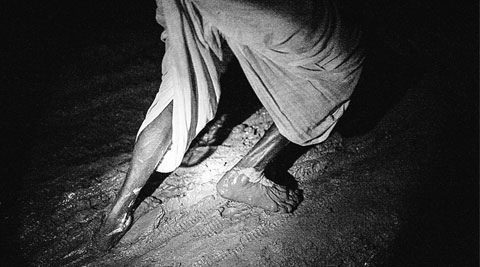*************************************************************************
Israeli-born Sephi Bergerson’s images document the clockwork precision of the last leg of the polio eradication drive in India.
*************************************************************************


Kusheshwar, beyond which lay the mighty Kosi river, was no end of the world, as Bergerson found out.
*******************************************************
*******************************************************
Kusheshwar Asthan East has no electricity. At least it didn’t till
September 2012. Sephi Bergerson stood in the inky black of the night,
torch in one hand, camera in the other, and clicked. “It was 4 am. The
flash would have killed the photograph. So I simply borrowed a torch
from someone and shot. It was something I did without much thought,”
says Bergerson.
So that’s how Kusheshwar Asthan East, a town in the flood plains of the Kosi river in Bihar’s Darbhanga district, remains framed — the road churned inside out after the rains, a man in dhoti, waist-down, his feet covered in slush as he strains to push something, possibly a cart. This is where the Israel-born Bergerson spent a night, one of the many he spent tracking India’s polio eradication campaign.
In 2011, with India on the verge of being declared polio-free, Unicef commissioned Bergerson and four other photographers — Anindito Mukherjee, Graham Crouch, Sandeep Biswas and Tim Georgeson — to document “the largest civil operation in the history of mankind”. Bergerson set off to Bihar’s Patna, Jogbani, Khagaria and Darbangha and found himself in some of the remotest corners of the country.
But Kusheshwar, beyond which lay the mighty Kosi river, was no end of the world, as Bergerson found out. If anything, the journey began here. If it wasn’t for this town, which served as the satellite office of the World Health Organisation (WHO) and Unicef, the vaccine would never have reached around 200 villages scattered in the flood plains of the Kosi.
For every round of the pulse polio immunisation campaign, this town wakes up at an unearthly 3 am, even earlier. The ice factory creaks open by the light of a flickering kerosene lamp, the vials are packed with ice packs in thermocol boxes and the vaccinators and volunteers set off — barefoot or on carts, through the thick slush, down to the river where the boxes are loaded on to the boat that then takes the vaccine to these villages. Bergerson’s camera would blink away, unobtrusively.
“The photographs are part of the last documentation of the polio programme in India. The idea was to show how the long arm of the project had reached the last child,” says Bergerson, in a telephone interview. The photographs, all shot in black-and-white because “it just seemed right”, are now part of a book, India’s Story of Triumph over Polio. In March this year, India was declared polio-free after three years without a single case being reported.
The sheer grit that sustained the polio project awed him, but by
then, Bergerson had spent about nine years in India and there were “very
few things that shocked” him. “I had already seen this side of India.
You don’t have to go that far, to some of the most remote corners, to be
‘shocked’,” he says of the country he has learnt to call “home”.
“In 2002, I was a commercial photographer in Israel, had married a couple of years earlier and wanted to become a documentary photographer. My wife Shefi is Israeli of Yemeni origin and we were looking to move out of Israel and decided, of all places, on India. She wanted to start a Yemeni restaurant in Rishikesh. The India we came to wasn’t the India of postcards but we stayed on and are happy with our choice of home,” says Bergerson, whose range of work covers everything from the slums of Dharavi to wedding photography.
Two years after he arrived in India, WHO approached him to document the polio programme. “In 2004, I travelled extensively through much of north India shooting the polio eradication drive. They were hoping that polio would be wiped out by 2005, but that didn’t happen. The project wasn’t as streamlined then as it is now and there were failures. But even after years of failure, the teams kept going. They reconsidered, changed, adapted, went step by step till they had an answer to every challenge. By 2011, the programme began working with the kind of precision you can’t imagine — like a Swiss watch or a German machine.”
So Bergerson peered into his view finder and watched as this “German
machine” in a thermocol icebox went about its business — through dingy
alleys, open drains, crowded mohallas. He stopped whenever the box
stopped at every child under five, a vial emerged from the ice box, the
child’s head was firmly held back for a few seconds, two precious drops
squeezed into her mouth, and a blob of indelible blue smeared on the
nail of her little finger. Bergerson also captured the “ancillary
industry” at work — the reluctant mothers being brought round, the
suspicious maulana who turned a polio foot soldier, the project
officials and volunteers who mapped every locality, every child. “It is
beyond stunning. The numbers are incredible. In Uttar Pradesh alone,
every month, half a million newborns are registered, mapped and
vaccinated. In India, the campaign had two million volunteers. It worked
simply because of the commitment of these people. These are
unbelievable numbers,” says Bergerson.
Bergerson hasn’t gone back to Kusheshwar Asthan East, but the town
would have certainly woken up from that night. Like the rest of India,
it’s now polio-free.
Source : The Indian Express , 13th April 2014

No comments:
Post a Comment